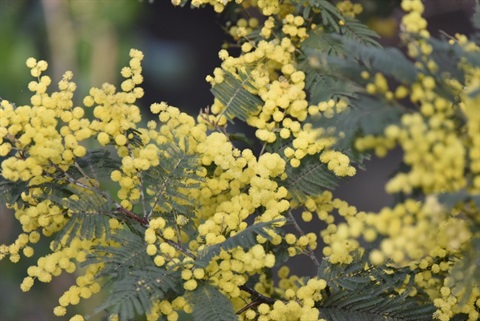Bush Crew diaries September 2024
Published on 19 August 2024

At right, Acacia dealbata (Silver Wattle)
Changes in the recent weather may not be the only noticeable change within the environment around Banyule. From late winter many acacia (wattle) species will begin to flower.
One of the earliest species to flower is Acacia dealbata (Silver Wattle), producing many beautiful yellow flowers. This is a good way to be able to distinguish this species from the similar looking and much later flowering A. mearnsii (Black Wattle). As the seasonal changes continue, other acacia species will also start flowering, such as A. paradoxa (Prickly or Hedge Wattle), a straggly to dense shrub with many thorns that creates a great habitat and refuge for small birds.
Another species beginning to flower just happens to also be the official floral emblem of Australia, A. pycnantha (Golden Wattle). This species requires cross-pollination between plants to set its seed. This process will occur when nectar loving birds come to feed and dislodge the pollen from the flower heads, continuing to do so when they visit multiple trees.
As lovely as flowering acacias are to observe, they play a significant role in the environment offering many diverse types of food to wildlife. Flower pollen and nectar producing glands provide food for birds and insects. Sap is produced from some species in the stems and trunk, helping sustain mammals throughout winter when food becomes scarce. Large amounts of seeds drop to the ground which then feed other bird and insect species. Wood borer grubs living within larger trees can be exposed and consumed by strong-beaked cockatoos.
Taller acacia trees can provide roosting sites for owls during the daytime or lookout perches for hunting birds of prey, while more dense and spiky shrubby acacias create excellent small bird refuge and nesting sites away from danger. Acacias also happen to be in the Fabaceae (pea) family. This family has a special association with Rhizobium bacteria in the soil that form nodules on the plants' roots, allowing the plant to extract nitrogen from the atmosphere from otherwise low nitrogen soil. This makes many acacia species great pioneer plants in the environment and can also be used when trying to establish cleared or degraded landscapes.
First Nations people have insightful knowledge for how acacias could be used for a wide range of purposes, including food, medicines, tools, hunting weapons, firewood, musical instruments, decorations and, of course, seasonal signals.
With an array of shapes, sizes and appearances for us to enjoy and such wonderful ecological value to offer, acacias do make great garden plants. Choosing species indigenous to your area from a local indigenous nursery is your best choice. Many species that are not native to Banyule may also have the potential to become highly invasive.